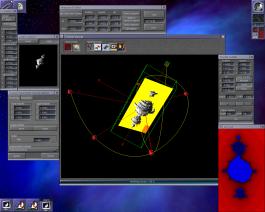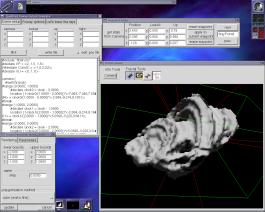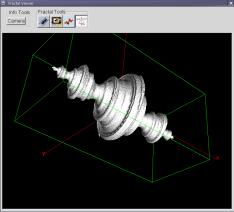QuatFract
deutsche Version

Intro
Downloads
Screenshots
MPEG movies
Zooming Sequenz
CVS history
Project Diary
Documentation
Contact
Intro
QuatFract is a GTK
(resp. gtkmm) program for interactive discovery of Julia sets in
quaternion space. Those are fractal shapes, whose
surface is visualized by polygonization algorithms with the help of
OpenGL. QuatFract was started as a software practical and is under
further development now. In addition to our QuatFract fractal viewer
we implemented a generic Viewer C++-class which can be used as
starting point for arbitrary OpenGL viewing programs.
Features
- Extremely userfriendly mouse control featuring rotating, rolling, zooming
(uses quaternions ;).
- A bounding box can be used to restrict rendering, so you are able
to zoom into the fractal and re-render smaller regions.
- A Cutter tool can be used to do 2-dimensional cuts into the fractal, to
view and explore them in 2D.
- Nice button plugin system that can be extended easily
- Waypoints around the fractal surface can be set which, after calculating
an interpolating spline, can be used to produce povray files, resulting in a
raytraced camera flight. (see example mpegs)
- The light settings can be interactively set with mouse control
Downloads
The new sources use autoconf/automake so you just can type ./configure and make to compile quatfract.
Or use anonymous cvs to directly check out the newest sources:
cvs -d :pserver:anonymous@pille.iwr.uni-heidelberg.de/export/home/softpr2/cvsroot login
hit enter when password is prompted, and then check out the sources with
cvs -d :pserver:anonymous@pille.iwr.uni-heidelberg.de/export/home/softpr2/cvsroot co quat
Screenshots
|
Juliamenge des IFS x^2 + C mit Cube-Rendering
|

|

|

|
the new features: LightControl, Cutter,
spline interpolation and Progress Bar
|
C = [ -0.2 0.8 0 0 ]
|
C = [ -1 -0.13 0 0 ], 131388 polygons
|
|
MPEG movies
QuatFract has a so called WaypointEditor and a
PovrayOutput window. With the WaypointEditor interactive waypoints can
be set around the visualized fractal. They are then connected by a
natural spline and a camera flight is rendered into povray scene
files. The following mpegs were created in that way:
|
MPEG movies
|

|

|
|
cubic Julia set / C = [ 0.2 1.15 0 0 ]
|
quadratic Julia set / C = [ -1 -0.13 0 0 ]
|
|
...read more.
documentation
At the end of our practical we wrote a
report (german).
It contains both a short mathematical description of
the quaternions and the algorithms we used and partly developed for
the visualization. Furthermore you can find a description of the
structure of the code and a short example on how to use our generic
Viewer as starting point for your own programs.
A class reference created with doc++
summarizes the classes we used and may act as documentation for the
use of the Viewer class.
contact
If you got questions, suggestions or critique just let us know:
David Reichert
Max Wiehle
Tobias Dyckerhoff
Tobias Dyckerhoff
Last modified: Mon Mar 10 17:12:59 CEST 2003


